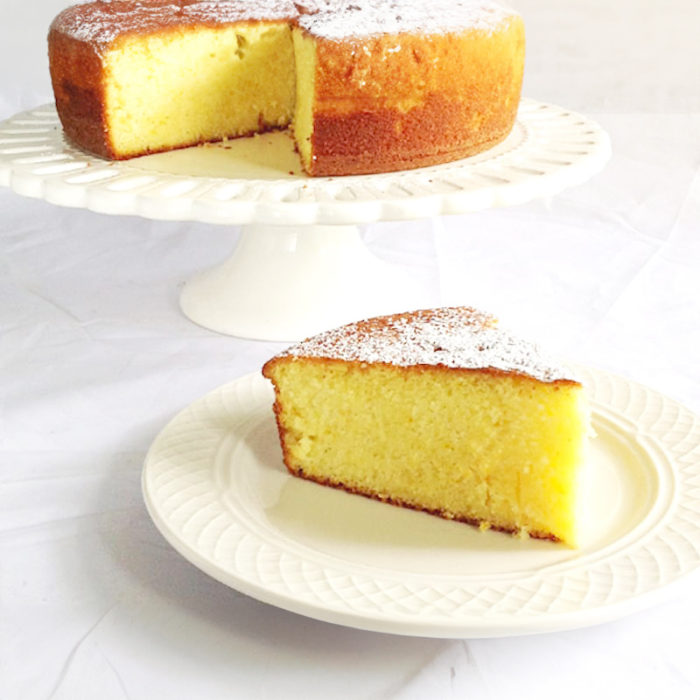This cake is tender and moist with a fresh hint of orange. The olive oil offers a unique flavor to compliment the citrus. Together, they are a match made in heaven.
There’s a bowl on my kitchen counter. In it are oranges, apples, pears, kiwi and bananas. At one point it also contained a few apricots, but I don’t think they managed to make it 24 hours before being eaten.
The other fruit, however, has been here a while. It’s all a part of our attempt to get our daughter to eat healthy. While she has to ask permission (and more often than not gets told no) for a sweet snack, she’s able to eat anything from that bowl that she wants, any time she wants.
The kicker is that she won’t do it. When I asked her about it recently, I was given this reason for opting to eat nothing instead of a piece of fruit. First, the bananas had little (minuscule) dots of brown on them. The pear also had a (one) brown spot.
The kiwi looked too strange and fuzzy and the apples hurt her loose (it’s fallen out since then) tooth. The oranges, which don’t spot, aren’t fuzzy and wouldn’t hurt her tooth, are too messy.
You know what I do when someone gives me that semi-understandable, yet utter ridiculous reason for not eating fruit?
I make cake.
How to Make Italian Orange and Olive Oil Cake
Preparing the Pan
- Preheat the Oven: Set your oven to 350°F (177°C).
- Prepare the Cake Pan: Line the bottom of a 10-inch (25 cm) cake pan with parchment paper. Grease the parchment and sides of the pan with unsalted butter, then dust lightly with flour to prevent sticking.
Making the Cake Batter
- Mix Wet Ingredients: In a large mixing bowl, use an electric mixer to beat the eggs with granulated sugar, orange zest, and kosher salt until well combined.
- Combine Liquid Ingredients: In a separate medium bowl, whisk together the orange juice and olive oil.
- Combine Wet and Dry Ingredients: With the mixer on low speed, gradually add the orange juice and olive oil mixture to the egg mixture. Then, gradually beat in 2 cups of flour in three additions, ensuring each addition is well incorporated before adding the next, until the batter is smooth.
Baking the Cake
- Bake the Cake: Pour the batter into the prepared pan. Place in the preheated oven and bake for 45 to 50 minutes, or until the cake is golden brown and a toothpick inserted into the center comes out clean.
- Cool and Serve: Allow the cake to cool completely in the pan. Once cool, remove from the pan, discard the parchment paper, and if desired, dust with confectioners’ sugar before serving.
Recipe Notes
- Flour Alternatives: If self-rising flour is not available, substitute with all-purpose flour mixed with 1 1/2 teaspoons of baking powder and 1/2 teaspoon of salt per cup of flour.
- Citrus Variations: Lemon can be used instead of orange for a different citrus twist.


Italian Orange and Olive Oil Cake
- Total Time: 1 hour 10 minutes
- Yield: 1 cake 1x
Description
This cake is tender and moist with a fresh hint of orange. The olive oil offers a unique flavor to compliment the citrus. Together, they are a match made in heaven.
Ingredients
- Unsalted butter, for greasing the pan
- 2 cups (250g) self-rising flour, plus more for dusting
- 4 large eggs
- 1 cup (200g) granulated sugar
- 2 tablespoons finely grated orange zest
- 1/2 teaspoon kosher salt
- 1 cup (240ml) fresh orange juice
- 1 cup (240ml) extra-virgin olive oil
- Confectioners’ sugar, for dusting (optional)
Instructions
Preparing the Pan
- Preheat the Oven: Set your oven to 350°F (177°C).
- Prepare the Cake Pan: Line the bottom of a 10-inch (25 cm) cake pan with parchment paper. Grease the parchment and sides of the pan with unsalted butter, then dust lightly with flour to prevent sticking.
Making the Cake Batter
- Mix Wet Ingredients: In a large mixing bowl, use an electric mixer to beat the eggs with granulated sugar, orange zest, and kosher salt until well combined.
- Combine Liquid Ingredients: In a separate medium bowl, whisk together the orange juice and olive oil.
- Combine Wet and Dry Ingredients: With the mixer on low speed, gradually add the orange juice and olive oil mixture to the egg mixture. Then, gradually beat in 2 cups of flour in three additions, ensuring each addition is well incorporated before adding the next, until the batter is smooth.
Baking the Cake
- Bake the Cake: Pour the batter into the prepared pan. Place in the preheated oven and bake for 45 to 50 minutes, or until the cake is golden brown and a toothpick inserted into the center comes out clean.
- Cool and Serve: Allow the cake to cool completely in the pan. Once cool, remove from the pan, discard the parchment paper, and if desired, dust with confectioners’ sugar before serving.
Notes
- Flour Alternatives: If self-rising flour is not available, substitute with all-purpose flour mixed with 1 1/2 teaspoons of baking powder and 1/2 teaspoon of salt per cup of flour.
- Citrus Variations: Lemon can be used instead of orange for a different citrus twist.
- Prep Time: 20 mins
- Cook Time: 50 mins
- Category: Dessert
- Method: Baking
- Cuisine: Italian Inspired














I love olive oil cake, and this was actually very very good!
Made it for my book club, and there wasn’t a single slice left!
Tried this recipe last night. The texture was perfect, moist and soft. However, I think I would LOVE a bit more orange flavor. Next time, I might add more zest or a hint of orange extract.
Does anyone have suggestions for a gluten-free version? I loved this, but it doesn’t work for my daughter’s diet.
Of course! You can substitute the self-rising flour with a gluten-free self-rising blend. Here’s a simple way to adjust the recipe:
– Look for a gluten-free flour blend that is designed for baking and includes a rising agent, similar to self-rising flour. Brands like King Arthur and Bob’s Red Mill offer gluten-free self-rising flour options.
– Ensure that the gluten-free flour blend you choose contains xanthan gum or guar gum, which helps to mimic the texture and elasticity of gluten in baked goods.
– You can use the same amount of gluten-free self-rising flour as the recipe calls for regular self-rising flour. The substitution is typically 1:1.
– Gluten-free flours can sometimes absorb liquid differently. If the batter seems too thick, you might need to add a little more orange juice or a splash of milk to reach the desired consistency.
– Keep the oven temperature the same, but be aware that the baking time might need a slight adjustment. Gluten-free cakes can sometimes take a little longer to bake. Use the toothpick test to ensure it’s fully baked through.
Fantastic use of olive oil in a dessert! It’s my go-to fat for cooking, but using it in a cake was a revelation. Added a nice depth to the cake’s flavor profile.
Made this for a family dinner and it was a hit! Even the kids loved it. I served it with a side of homemade whipped cream spiked with orange liqueur. Delicious!
That sounds lovely, I’m all for orange liqueur in whipped cream!
As a professional baker, I must say this cake’s texture and flavor balance is on point. The olive oil isn’t overpowering, and the orange zest provides a fresh burst. Well done!